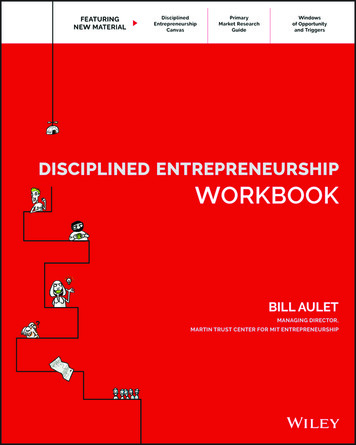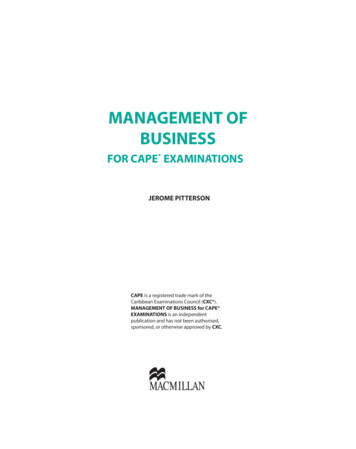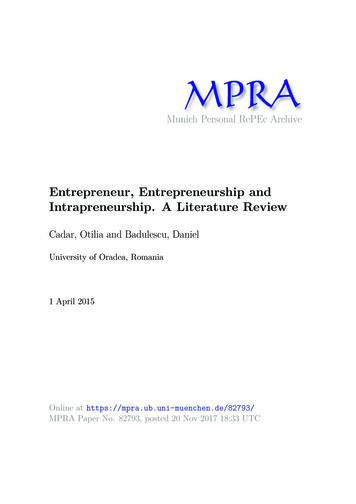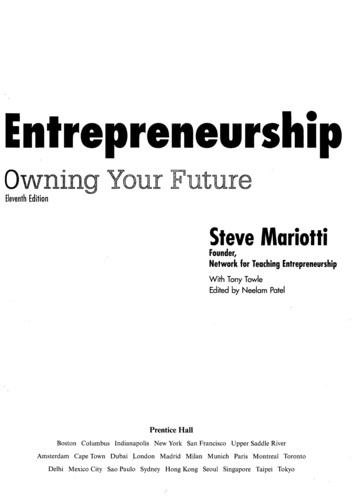
Transcription
Disciplined EntrepreneurshipWorkbook
Disciplined EntrepreneurshipWorkbookBill AuletIllustrations byMarius UrsacheEdited byChris Snyder
Cover image: Marius UrsacheCover design: WileyThis book is printed on acid-free paper.Copyright 2017 by Bill Aulet. All rights reservedPublished by John Wiley & Sons, Inc., Hoboken, New JerseyPublished simultaneously in CanadaNo part of this publication may be reproduced, stored in a retrieval system, or transmitted in any form or by any means, electronic,mechanical, photocopying, recording, scanning, or otherwise, except as permitted under Section 107 or 108 of the 1976 United StatesCopyright Act, without either the prior written permission of the Publisher, or authorization through payment of the appropriate per-copyfee to the Copyright Clearance Center, 222 Rosewood Drive, Danvers, MA 01923, (978) 750-8400, fax (978) 646-8600, or on the Web atwww.copyright.com. Requests to the publisher for permission should be addressed to the Permissions Department, John Wiley & Sons, Inc.,111 River Street, Hoboken, NJ 07030, (201) 748-6011, fax (201) 748-6008, or online at www.wiley.com/go/permissions.Limit of Liability/Disclaimer of Warranty: While the publisher and author have used their best efforts in preparing this book, they makeno representations or warranties with the respect to the accuracy or completeness of the contents of this book and specifically disclaim anyimplied warranties of merchantability or fitness for a particular purpose. No warranty may be created or extended by sales representativesor written sales materials. The advice and strategies contained herein may not be suitable for your situation. You should consult with aprofessional where appropriate. Neither the publisher nor the author shall be liable for damages arising herefrom.For general information about our other products and services, please contact our Customer Care Department within the United States at(800) 762-2974, outside the United States at (317) 572-3993 or fax (317) 572-4002.Wiley publishes in a variety of print and electronic formats and by print-on-demand. Some material included with standard print versionsof this book may not be included in e-books or in print-on-demand. If this book refers to media such as a CD or DVD that is not includedin the version you purchased, you may download this material at http://booksupport.wiley.com. For more information about Wiley products,visit www.wiley.com.Library of Congress Cataloging-in-Publication Data has been applied for and is on file with the Library of Congress.978-1-119-36579-2 (paperback)978-1-119-36577-8 (ePDF)978-1-119-36578-5 (ePUB)Printed in the United States of America10 9 8 7 6 5 4 3 2 1
I dedicate this book to all my students who make my so-called “job”the greatest one in the world. You give me energy every day. This one is for you.
ContentsPrefacexiiiIntroducing the Disciplined Entrepreneurship CanvasxvWhat Is the Disciplined Entrepreneurship Canvas, and Why Is It Important?How to Approach the Disciplined Entrepreneurship CanvasExample of Using the Disciplined Entrepreneurship Canvas with Feedbackstep 0How Do I Get Started? Should I? 1Your PassionYour TeamComing Up with an Idea or a TechnologyHybrid Idea: Mix of Market Pull and Technology PushStep 1Market Segmentation 11What Is Step 1, Market Segmentation?Why Do We Do This Step, and Why Do We Do It Now?Process GuideBonus TopicA Practical Guide to Primary Market ResearchWhat Is Primary Market Research?WorksheetsStep 2Select a Beachhead Market39What Is Step 2, Select a Beachhead Market?Why Do We Do This Step, and Why Do We Do It Now?Process GuideGeneral Exercises to Understand ConceptWorksheetsDecision for Team to Sign Off on the Beachhead Marketvii23
viiiContentsStep 3Build an End User Profile for the Beachhead Market 47What Is Step 3, Build an End User Profile for the Beachhead Market?Why Do We Do This Step, and Why Do We Do It Now?Process GuideGeneral Exercises to Understand ConceptWorksheetStep 4Estimate the Total Addressable Market (TAM) for the Beachhead Market 53What Is Step 4, Estimate the Total Addressable Market (TAM) for the Beachhead Market?Why Do We Do This Step, and Why Do We Do It Now?Process GuideGeneral Exercises to Understand ConceptWorksheetsAdvanced Topics: Bottom‐Up TAM AnalysisStep 5Profile the Persona for the Beachhead Market 65What Is Step 5, Profile the Persona for the Beachhead Market?Why Do We Do This Step, and Why Do We Do It Now?Process GuideGeneral Exercises to Understand ConceptWorksheetsAdvanced Topic: Persona Profiles for Multisided End User MarketStep 6Full Life Cycle Use Case 79What Is Step 6, Full Life Cycle Use Case?Why Do We Do This Step, and Why Do We Do It Now?Process GuideGeneral Exercises to Understand ConceptWorksheetsStep 7High-Level Product Specification 87What Is Step 7, High-Level Product Specification?Why Do We Do This Step, and Why Do We Do It Now?Process GuideGeneral Exercises to Understand ConceptWorksheetsAdvanced Topic: High-Level Product BrochureStep 8Quantify the Value Proposition 95What Is Step 8, Quantify the Value Proposition?Why Do We Do This Step, and Why Do We Do It Now?Process GuideGeneral Exercises to Understand ConceptWorksheets
ixContentsStep 9Identify Your Next 10 Customers 101What Is Step 9, Identify Your Next 10 Customers?Why Do We Do This Step, and Why Do We Do It Now?Process GuideGeneral Exercises to Understand ConceptWorksheetsStep 10Define Your Core 113What Is Step 10, Define Your Core?Why Do We Do This Step, and Why Do We Do It Now?Process GuideGeneral Exercise to Understand ConceptWorksheetStep 11Chart Your Competitive Position119What Is Step 11, Chart Your Competitive Position?Why Do We Do This Step, and Why Do We Do It Now?Process GuideGeneral Exercise to Understand ConceptWorksheetStep 12Determine the Customer’s Decision-Making Unit (DMU) 125What Is Step 12, Determine the Customer’s Decision-Making Unit (DMU)?Why Do We Do This Step, and Why Do We Do It Now?Process GuideGeneral Exercises to Understand ConceptWorksheetStep 13Map the Process to Acquire a Paying Customer 131What Is Step 13, Map the Process to Acquire a Paying Customer?Why Do We Do This Step, and Why Do We Do It Now?Process GuideGeneral Exercises to Understand ConceptWorksheetsBonus TopicWindows of Opportunity and Triggers143What Are Windows of Opportunities and Triggers?Why Are They Important and Why Now?Process GuideGeneral Exercises to Understand ConceptWorksheet
xContentsStep 14Estimate the Total Addressable Market (TAM) Size for Follow-on Markets 153What Is Step 14, Estimate the Total Addressable Market (TAM) Size for Follow-on Markets?Why Do We Do This Step, and Why Do We Do It Now?Process GuideGeneral Exercises to Understand ConceptWorksheetStep 15Design a Business Model 161What Is Step 15, Design a Business Model?Why Do We Do This Step, and Why Do We Do It Now?Process GuideGeneral Exercises to Understand ConceptWorksheetStep 16Set Your Pricing Framework 169What Is Step 16, Set Your Pricing Framework?Why Do We Do This Step, and Why Do We Do It Now?Process GuideGeneral Exercises to Understand ConceptWorksheetStep 17Estimate the Lifetime Value (LTV) of an Acquired Customer 175What Is Step 17, Estimate the Lifetime Value of an Acquired Customer?Why Do We Do This Step, and Why Do We Do It Now?Process GuideGeneral Exercises to Understand ConceptWorksheetStep 18Map the Sales Process to Acquire a Customer 181What Is Step 18, Map the Sales Process to Acquire a Customer?Why Do We Do This Step, and Why Do We Do It Now?Process GuideGeneral Exercises to Understand ConceptWorksheetsExampleStep 19Estimate the Cost of Customer Acquisition (COCA) 199What Is Step 19, Estimate the Cost of Customer Acquisition (COCA)?Why Do We Do This Step, and Why Do We Do It Now?Process GuideGeneral Exercises to Understand ConceptWorksheets
ContentsStep 20Identify Key Assumptions 209What Is Step 20, Identify Key Assumptions?Why Do We Do This Step, and Why Do We Do It Now?Process GuideGeneral Exercises to Understand ConceptWorksheetStep 21Test Key Assumptions 215What Is Step 21, Test Key Assumptions?Why Do We Do This Step, and Why Do We Do It Now?Process GuideGeneral Exercise to Understand ConceptWorksheetStep 22Define the Minimum Viable Business Product (MVBP) 221What Is Step 22, Define the Minimum Viable Business Product (MVBP)?Why Do We Do This Step, and Why Do We Do It Now?Process GuideGeneral Exercise to Understand ConceptWorksheetStep 23Show That “The Dogs Will Eat the Dog Food” 225What Is Step 23, Show That “The Dogs Will Eat the Dog Food”?Why Do We Do This Step, and Why Do We Do It Now?Process GuideGeneral Exercise to Understand ConceptWorksheetStep 24Develop a Product Plan 231What Is Step 24, Develop a Product Plan?Why Do We Do This Step, and Why Do We Do It Now?Process GuideGeneral Exercises to Understand ConceptWorksheetsBeyond the 24 Steps241What Is Missing in the 24 Steps?WorksheetExercise Answers245Index253xi
PrefaceThe originaL Disciplined Entrepreneurship book laid out a rigorous but practical pedagogy forinnovation-driven entrepreneurship. It has fundamentally changed the course of entrepreneurshipeducation from a storytelling approach to a toolbox and systematic framework. But there is onlyso much that can be accomplished in a single 250-page book. This workbook builds off DisciplinedEntrepreneurship to provide a way to more easily engage with the 24 Steps.Our goal at the Martin Trust Center for MIT Entrepreneurship is to develop high-quality entrepreneurship education and make it accessible, not just to MIT’s full-time students but also to millionsof people worldwide. That is why I wrote Disciplined Entrepreneurship, taught several online courseson edX, and with my colleagues write online articles and tools to help clarify key concepts about ourmethodical approach to entrepreneurship.The demand from entrepreneurs and instructors for additional materials to help them implementthe 24 Steps has been simultaneously rewarding and overwhelming. There needed to be a more scalable solution, and that is the purpose of this workbook.In this book, I provide templates and additional advice on how to implement each of the 24 Steps.You can use these templates on your own startup or as classroom deliverables to assess your students’understanding of the topics. This workbook is not a replacement for Disciplined Entrepreneurship butrather a complement to it. It is expected that you will go back and forth between Disciplined Entrepreneurship and this workbook in order to gain a full understanding of each step.The 24 Steps is an iterative process, so always make sure you are proactively revising your workas you go through the steps. Something that you do in Step 23 is likely to affect Step 11, or Step 9will affect Step 5, and so on. Also, do not feel confined by these templates if you need to make somemodifications to better suit the needs of the industry or specific characteristics of your startup.The 24 Steps approach is a toolbox of the best methodologies available for entrepreneurs, and Icontinually evolve it and survey the landscape to take in new and/or better tools to improve the framework. You’ll see two new chapters in this workbook, one on primary market research and another onwindows of opportunity and triggers. I hope that many others around the world will continue to testand contribute to the 24 Steps to make the framework even better over time. The collective wisdomof the community is better than any individual—plus many hands make for lighter and faster work.Since the time I first published Disciplined Entrepreneurship, it has become even more clear thatwe need high-quality, rigorous entrepreneurship education and training sooner rather than later. Thecritical need for a serious body of knowledge on innovation-driven entrepreneurship has never beengreater—and it will only get more so in the future. Please “lean in,” as Sheryl Sandberg would say, andhelp us with this cause.Additional materials, including electronic versions of some of the worksheets herein, will be available at www.disciplinedentrepreneurship.com.xiii
Introducing the Disciplined Entrepreneurship CanvasThis is new material that was not covered in Disciplined Entrepreneurship. The Canvas is a tool youwill fill out as you go through the 24 Steps.What Is the Disciplined Entrepreneurship Canvas, and Why Is It Important?The Disciplined Entrepreneurship Canvas is a one-page overview of the Disciplined Entrepreneurshipapproach to entrepreneurship. The Canvas functions like a synopsis of your current status so you cansee what you have done and what you have not done, across 10 major areas that map to the 24 Steps.I have seen the value in life of having a concise visual that gives a team feedback on their progressin the midst of the battle. I have also seen entrepreneurs building workarounds for just this functionwhen trying to use the Disciplined Entrepreneurship approach, so there is clearly value in trackingyour progress on the long journey through the 24 Steps.The Disciplined Entrepreneurship Canvas will allow you to quickly assess the big picture of where you stand,and where your strengths and weaknesses are, so you can make adjustments.xv
xviIntroducing the Disciplined Entrepreneurship CanvasHow to Approach the Disciplined Entrepreneurship CanvasAs Disciplined Entrepreneurship has been broadly deployed, a frequent question I get is how tointegrate the 24 Steps framework with the Business Model Canvas made popular by Business ModelGeneration by Alexander Osterwalder and Yves Pigneur. In fact, before I wrote Disciplined Entrepreneurship, I used to use in my classroom the Business Model Canvas and then the Lean Canvas by AshMaurya, but I did not find an easy, suitable way to integrate them with teaching the 24 Steps.As nature abhors a vacuum, numerous people have constructed their own canvases for the Disciplined Entrepreneurship framework, led by Laurie Stach (MIT Launch), Floriano Bonfigli (IstitutoAdriano Olivetti Business School—ISTAO Startup Lab), Patrick Kirby (Michelin—vice president ofinnovation and entrepreneurship), Johannes Mutzke (Michelin—Global Innovation Council), MateoNakach and Jorge Sanchez (Build-Your-Business Consulting Group), and Michael McCausland(Leadership Institute for Entrepreneurs).They have pushed and inspired me to see the value of a one-page canvas that shows how you aredoing. In sports, a coach often tracks progress in the game in a summary fashion and then conveyskey information to his team on what they are doing well and what they need to focus more on if theyare to win the game. A basketball coach’s synopsis, for instance, will not only have the score but alsothe time left in the game, how many fouls each team and each player has, and other key indicators.Likewise, an entrepreneurship canvas gives you the big picture in one snapshot and allows you to seewhat you need to work on.The simple summary does not capture the full richness of your situation, and as such it isnot a perfect indicator of your success. Nor does the simple summary tell you why things havehappened and how to fix things. So while it is limited in its usefulness, it does have the benefit ofsimplicity.I have based the Disciplined Entrepreneurship Canvas off the Six Themes of the 24 Steps fromDisciplined Entrepreneurship, expanding two of the themes and adding two more sections. The resulting Canvas maintains the specificity, logic, and rigor of the 24 Steps.More so than other canvases, this canvas has a suggested initial sequential nature to it. You shouldstart with Section 1 and then follow the arrows to move through the canvas. There should also beiteration, but providing a general prescriptive initial flow is helpful and an important part of the Disciplined Entrepreneurship approach.Turn to page xviii to see the Canvas. Each section maps quite well to specific steps:Section 1, Raison d’Être (aka Reason for Existing): Step 0Section 2, Initial Market: Steps 1, 2, 3, 4, 5, and 9Section 3, Value Creation: Steps 6, 7, and 8Section 4, Competitive Advantage: Steps 10 and 11Section 5, Customer Acquisition: Step 12, 13, and Windows of Opportunity/TriggersSection 6, Product Unit Economics: Steps 15, 16, 17, and 19Section 7, Sales: Step 18Section 8, Overall Economics: Step 19 (parts)Section 9, Design and Build: Steps 20, 21, 22, and 23Section 10, Scaling: Steps 14 and 24
Introducing the Disciplined Entrepreneurship CanvasxviiThe fit between the steps and the Canvas is not perfect, but it still produces a framework that isuseful and ties into the worksheets and additional information in this workbook.When I used other canvases in my classroom, the frameworks were helpful, but they oftenneeded to be customized. I would likewise encourage you to think of the Disciplined Entrepreneurship Canvas below not as a fixed edict, but rather as a framework that can be customized asappropriate. If it does not quite fit, that is okay. Go ahead and customize it, but it should at leastgive you a good start.Note: Filling out the Disciplined Entrepreneurship Canvas fully requires expertise that you will gain fromreading both Disciplined Entrepreneurship and this workbook. Do not be discouraged or frustrated thatyou don’t know how to fill out all the sections at first. It will be a good guide for you to make sure youhave absorbed all the material in both books. Fill out what you can and then continually update it as youlearn more.Example of Using the Disciplined Entrepreneurship Canvas with FeedbackOld friend and master illustrator of this book, Marius Ursache, offered to test-drive the Canvasfor his project, the Disciplined Entrepreneurship Toolbox (www.detoolbox.com). I should note thatthe 24 Steps framework has been used not just for startups but for projects/product design and development in large corporations, government organizations, investment situations, community organizations, educational institutions, religious groups, student clubs, and even creative arts groups. Once itwas used for a piano concert. (Thanks for letting us know, Amanda von Goetz!)Turn to page xix to see his first draft of his Canvas. Below are my comments on it so that you cansee what you should be considering when you fill out your Canvas. Marius’s draft is quite good, so Iwill focus my comments on where it could be improved, as well as how the Canvas will help Mariusdiscover where he should focus his attention next:1. Raison d’Etre: The founder passions, values, initial assets, and initial idea are good and canbe refined, but the real area I would focus on is the mission. It is too general and is notreally unique or inspiring. Having a clear mission is valuable for two reasons—it shows whythe world will be a better place thanks to your venture, and equally important, it tells youwhat you will not be doing. This guidance on what you will be not doing will help you toget the right people on your team. To build a successful team you need three things: a common vision, shared values, and complementary skills. As you can see, it starts with commonvision, so clarity on why you are in business is fundamental to your success in an environment that will be fraught with failure and other discouraging moments. That common visionkeeps you marching on.2. Initial Market: Again, there is lots to like in the End User Profile, TAM, and Next 10 Customers.The Beachhead Market and Persona draw my attention and concern. First, I worry that theBeachhead Market is two different markets. There cannot be a plural of Beachhead Market.Second, I worry even more that there is no Persona. I know picking a Persona can be a bit
xviii
xix
xxIntroducing the Disciplined Entrepreneurship Canvasuncomfortable and you will not find the perfect one to start, but Marius should pick the bestone he has and then execute the process with it and look to upgrade the Persona over time.3. Value Creation: There is a great deal of information to be summarized in this box and it isa real challenge. I worry that the very important use case is so truncated that it is not clearhow well this has been developed. Likewise, the other three items have to be summarizedin such a compact way, so while they seem encouraging I have a lot of questions. I definitelywant to see the product brochure. But all in all, good. At this point, I am starting to see thatthe two Beachhead Markets defined in the Initial Market section may be intractably linked,and rather than two separate markets, they could possibly be seen as a two sided-market. Thiswould be an area I would ask a lot of questions about.4. Competitive Advantage: In the moats section, Marius lists “network effect,” but I think thatis actually the Core. What Marius lists for the Core definitely is not a Core, but rather is thebenefit that customers will get. A Core is an internal capability you will have that is unique ormuch stronger than anyone else. I worry when I see network effect as a Core because whileit can be a great one, it is rarely achieved. And if is not achieved, then the company has nodefensible advantage over others, who will be able to follow you into the market at a lowercost by learning from the first mover’s mistakes.5. Customer Acquisition: The Decision-Making Unit (DMU) seems to be to be too simplistic(although I like that he has identified the chief product officer). Who are the DMU’s primaryinfluencers? The Decision-Making Process is too simplistic and does not address creatingawareness with the target market enough. The windows of opportunity are a good start, butthe possible triggers section is not developed in any creative way. This section, like much ofthe Canvas (and like what I’d expect for a first pass on any canvas), is too general and lackingin specifics to this situation.6. Product Unit Economics: I like that these are general estimates and that they do not try toconvey a level of precision that is not attainable at this point. The short-term Cost of Customer Acquisition (COCA) of 10 seems absurdly low to me and I am confident that uponcloser evaluation, Marius will find this number to be much higher, which is expected in theshort term. It would be extremely unusual to see a short-term Lifetime Value (LTV) of 200with only a short-term COCA of 10, or a short-term LTV of 15,000 with a short term COCAof only 2,000. This immediately makes me discount the medium term and long term where Iam confident that the COCA is still too low. But if the LTVs are to be believed, the businesswill be able to handle the actual COCA. Notice how easy it is to get a sense of the businessfrom just a few numbers!7. Sales: Oh my goodness! With the very low COCA from the previous section, I expected tosee no direct sales channel utilization in this section (forgoing direct sales is risky in the shortterm), but there it is as the second option. He’ll really need to think about how to minimizeuse and cost of direct sales (likely use inside sales instead of field sales, for starters) and touse other sales methods to keep COCA down. Maybe he can do online chat sales early on sothat inside sales is more affordable. I think “robo-sales” using big data analysis and preferenceengines is probably the way to go. I am feeling even less confident about the COCA calculations now, and I would dig deeper to make sure the unit economics model gets refined. Thementality of the organization needs to be more focused on designing the sales process to haveno human interaction from the company’s side in the near future, so that the COCA does notgrow out of control.
Introducing the Disciplined Entrepreneurship Canvasxxi8. Overall Economics: The R&D expense and the G&A expense items seem reasonable sincethe work is being done in Romania, not the United States, but the LTV/COCA ratio still bothers me because I think the actual COCA is higher. However, this part of the Canvas showsme that if the LTV is accurate, there is room for the COCA to be higher and still have aneconomically sustainable and attractive business entity.9. Design & Build: The key assumptions are too few and too general. The assumption tests donot yet line up with the key assumptions. The Minimum Viable Business Product (MVBP) isalready up and running, so there is valuable information that can be gained from this investment so far. The tracking metrics are generally correct, but are also more general than I wouldlike to see; for example, they do not have a time frame indicated.10. Scaling: What Marius put here is very general, but that is not as much a problem as it wouldbe in the other sections, because you won’t have much clarity this early on. That being said,Marius should keep an eye on this section going forward and update it quarterly based on newinformation, which will be coming in as he engages in the market and learns from iterations onearlier steps.
step 0How Do I Get Started? Should I?Before you start this 24-step journey, you first want to know two things:1. Do I want to start a company?2. Do I have an idea or technology that I can do a Market Segmentation on (Step 1)?Starting a company is not easy—it’s the exact opposite. It will be really, really difficult and humbling throughout the journey. So do you really want to start a company? How do you optimize yourchances of reaching a satisfying reward at the end? What kind of preparation do you need so thatyou start out with your eyes wide open, fully understanding what a startup entails and having doneeverything you can to increase your odds of success?By the Book: See pages 15-21 of Disciplined Entrepreneurship for basic knowledge on this step.1
2Disciplined Entrepreneurship WorkbookIn Step 0 of Disciplined Entrepreneurship, I said that people interested in entrepreneurship typically either have an idea, a technology, or a strong interest in entrepreneurship. I discussed how someone without an idea or technology can think about what knowledge and skills they have and whatideas/technologies might flow from there.Here, I emphasize unequivocally that if you’re looking to radically impact the world, you neednot just an idea or technology, but you also need a passion to keep going through good times and bad.You’ll also need cofounders who can help round out the skills and knowledge leading the company.MIT’s research shows that solo founders struggle compared to startups with founding teams.1In this workbook, I’ll first walk you through exercises to assess and define your starting point sothat you are better equipped to determine whether and how you want to proceed.Your PassionI start with passion because if you don’t have this, you will never succeed. It is a necessary condition(you must have it) but not a sufficient one (you need other things, too). Without passion, when you hitthose tough times—and you will, without question—you will not be able to fight through.By definition, a startup is about doing something that has never been done before. You are experimenting every day in new terrain, and you and your team will be way out of your comfort zone. Youand they must be. It is all so new. You hope to succeed, but you will fail, in ways big and small, andoften. Failed experiments are part of the startup experience. Just like in sports, where no great playerhas ever made all the shots he takes nor won every game she plays, you will do a lot of things thatdon’t work right away, or don’t work at all. You have to have a passion to fight through these temporary setbacks.Passion ChecklistI understand that 11Founding a company will be really, really hard and I still want to do it.2It will be a lengthy process loaded with humiliating failures along the way, andI must learn from them and not take them personally.3I cannot do it alone.4The path to success is not an algorithm with set rules to follow, but aniterative process where I can only increase or decrease the odds of success,but I cannot guarantee anything. Even if I achieve success, it is only temporary.5The goal is to make an “anti-fragile” organization—one that gets strongerover time when faced with problems, failures, uncertainty, and surprises.6When others provide advice, I will listen, but I will also recognize that it is upto me to choose which advice to implement, and how to implement it, sinceonly I own the final results and accountability.7I will have to leave my comfort zone every day to grow and continue tobe successful.8I am doing this for more than the money. I believe in my cause and my team.YesNoEdward B. Roberts, Entrepreneurs in High Technology: Lessons from MIT and Beyond (New York: Oxford University Press, 1991), 258.
Step 0: How Do I Get Started? Should I?3You may want to consider additional questions customized to your personal situation. Thegoal is to gauge whether you meet the minimal level of “informed passion” that is required to starta company.If you did not answer “Yes” to all of these questions, don’t start a company today.And that’s okay. I estimate that at least half of my students fall into the category of what I call the“entrepreneurial tourist” or “curious/exploratory entrepreneur.” These are people who are interestedin learning about how to start a company, but they’re not ready to quit their job tomorrow and pourtheir lives into a fledgling company. Some of my other students are interested in corporate entrepreneurship, or in being an “entrepreneurship amplifier,” where they work to increase interest in entrepreneurship and build up resources that will support startups.2All of these people will benefit from going through the 24 Steps with some idea or technology sothat they better understand the level of detail that goes into starting a company. And someday if theybecome ready to start a company, they will have a much stronger set of skills and knowledge readyto use. If you are interested in entrepreneurship, I encourage you to go through Disciplined Entrepreneurship and this workbo
The originaL DiscipLineD enTrepreneurship book laid out a rigorous but practical pedagogy for innovation-driven entrepreneurship. It has fundamentally changed the course of entrepreneurship education from a storytelling approach to a toolbox and systematic framework. But there is only so much that can be










